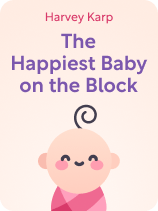

This article is an excerpt from the Shortform book guide to "The Happiest Baby on the Block" by Harvey Karp. Shortform has the world's best summaries and analyses of books you should be reading.
Like this article? Sign up for a free trial here.
Does your baby cry all day and night? How do you soothe a colic baby?
In The Happiest Baby on the Block, Harvey Karp offers a soothing technique that simulates the comfort sensory “middle ground” babies experience in the womb. This technique (consisting of five methods) helps colic babies who are too stimulated or not getting enough stimulation.
Continue reading to learn how to soothe a colic baby.
How to Activate the Calming Response
Karp argues that all babies have an instinctive “calming response” when they’re exposed to these sensations. This reflex evolved because while in the womb, a calmer fetus moves less and is, therefore, less likely to get into the transverse or breech positions (shifting onto their side or feet-down), which can cause dangerous complications during childbirth.
Karp strongly recommends that you always soothe your crying baby. His technique to help you learn how to soothe a crying baby consists of five different methods (what he calls the Five Ss), each of which simulates a different part of being in the womb to activate the calming response. These techniques can and should be mixed, matched, and used simultaneously—every baby will respond to them differently, so you’ll have to learn which combination works best for your baby.
(Shortform note: Some researchers have hypothesized that elements of the calming response evolved to keep babies safe outside of the womb as well. One study on the calming effect of maternal carrying suggested that babies become relaxed when held by their mothers because this makes them easier to pick up, hold, and manage—which could make all the difference in a dangerous situation where a mother has to flee with her baby.)
1) Swaddling
Karp explains that swaddling, or wrapping a blanket around your baby, simulates the constriction of the womb. In addition to soothing your baby, swaddling helps manage their movements and reactions so it’s easier to use the other parts of Karp’s technique. Karp says you should only swaddle your baby when they’re crying or sleeping—the rest of the time, they should be unwrapped and free to explore the world.
(Shortform note: In addition to reducing a baby’s response to sensory information, pediatric research suggests swaddling can also help soothe physical pain and discomfort. This means swaddling may prove effective for managing colic caused by physical symptoms (which we discuss in Part 2) as well.)
How to Swaddle Your Baby
Karp calls this method of swaddling the Down-Up-Down-Up (DUDU) wrap:
- Lay a blanket out in a diamond shape. Fold the top corner down to the center.
- Place your baby on the blanket with their neck right above the edge of the top fold.
- Hold your baby’s right arm straight at their side with their hand facing down. Then grab the blanket four inches from their right shoulder, pull it snugly down and right across their body, and tuck the rest under their left buttock. Grab the free blanket by their left shoulder and tug it to remove slack.
- Hold your baby’s left arm against their side with their hand facing down. Then bring the bottom corner of the blanket up to their left shoulder, tucking it snugly around their left arm.
- Grab the blanket a few inches from your baby’s left shoulder and pull it down to their upper chest, forming the other half of a “V-neck.” Hold it there with one hand.
- Grab the last corner and pull it straight out to remove slack. Then lift it and tie it straight across your baby’s arms, like a belt.
(Shortform note: It may be helpful to watch a video of someone performing the DUDU wrap if you’re having difficulty visualizing the process.)
Throughout the swaddling process, make sure you keep your baby’s legs loose enough to bend—this will prevent any hip problems.
(Shortform note: If your baby doesn’t seem to like being swaddled, there are some changes you can make to your technique that might help. If your baby doesn’t like having their arms restrained, you can leave the arms out of the swaddle. Alternatively, if your baby tends to kick or squirm their way out of a swaddle, you can also try a velcro or zip-up swaddle or a sleeping sack instead of a blanket.)
2) Side/Stomach
The second method Karp describes is holding your baby so that they’re on their side or stomach—this is the same position babies are in while inside the womb. Note that your baby should not sleep on their side or stomach, as this increases the risk of Sudden Infant Death Syndrome, or SIDS. Karp explains baby carriers and slings can keep your baby in this position.
(Shortform note: Karp argues that baby slings and carriers are safe so long as you ensure your baby’s head and neck are supported and their mouth and nose are unobstructed. However, the International Hip Dysplasia Institute recommends avoiding prolonged use of these products for babies under six months of age—especially if they keep the baby’s legs extended straight out and close together, as this increases the risk of hip dysplasia.)
How to Hold Your Baby
Karp also describes three techniques you can use to hold your baby on their side or stomach:
- Over-the-shoulder: Hold your baby so their body weight presses their stomach against your shoulder.
- Forearm straddle: From a position on their back, roll your baby onto your forearm so their arms and legs straddle it and their head is supported by your hand. With your palm against their cheek and your fingers cradling their head, their face will be free to breathe.
- Outward cradle: Cradle your baby like you would for breastfeeding, but face them away from you—with their head and neck in the crook of your elbow and their stomach pressed against your arm instead of your torso. (Shortform note: As with swaddling, you may find it useful to watch a video demonstrating these three holds and how to move your baby into position.)
(Shortform note: In addition to the dos of holding your baby Karp provides, there are two major don’ts experts suggest you keep in mind. First, don’t leave their head and neck unsupported—babies don’t develop the ability to hold their heads up on their own until around four months of age. Therefore, supporting the head and neck yourself is important so they don’t flop over suddenly and hurt your baby. Second, don’t pick your baby up by the armpits, as this can cause arm or shoulder injuries.)
3) Shushing
The third method Karp discusses is shushing, or providing some kind of white noise or ambient sound. This noise, he explains, helps simulate the relatively loud environment of the womb—namely the sound of blood rushing through arteries. (Shortform note: While in the womb, a fetus hears more than just the internal sounds of blood pumping and digestion—they also learn to recognize the voices of their parents by the third trimester. This is potentially why the sound of your speaking voice can soothe them as well.)
How to Shush Your Baby
Karp recommends using some form of white noise for all sleeping and crying periods. These noises should be moderately loud—your baby needs to be able to hear the shushing over their own crying, though you can reduce the volume when they start to relax. White noise also doesn’t help babies sleep until a volume of about 60 decibels, the equivalent of a shower or dishwasher running. As long as you keep the noise around this level, it won’t hurt your baby’s hearing.
In the moment, you can shush your baby by making a “shh” sound a few inches from their ear. For more extended periods, Karp recommends using continuous sounds (rather than something irregular or sporadic like ocean waves). He suggests using higher-pitched white noise to soothe crying and lower-pitched white noise to facilitate sleeping. You can keep using white noise throughout the first year, as your baby will likely continue to struggle with sleep as their calming response fades.
(Shortform note: In addition to using white noise, you can also help keep the noise in your baby’s room consistent through soundproofing—especially if you live in a high-traffic area, or somewhere else with lots of loud, sudden outside noise. You can soundproof your baby’s room with heavy blackout curtains, by closing doors and windows tightly, or even with soundproofing fabric or foam for walls and ceilings. However, Karp emphasizes that a too-quiet room can also contribute to colic, which suggests that you should pair soundproofing with white noise.)
4) Swinging
Karp’s fourth method is swinging, or rhythmically moving your baby. While inside the womb, fetuses are jiggled, bumped, and rocked nearly constantly whenever their mothers move. Swinging helps simulate this motion to trigger a calming response.
(Shortform note: After the book’s publication, Karp designed and promoted a robotic bassinet that automatically swings your baby. He suggests it’s a natural extension of his other techniques, allowing caregivers to rest while their baby is still soothed. Some pediatricians believe more research needs to be done to understand the effectiveness of mechanical versus caregiver swinging, though.)
How to Swing Your Baby
Karp recommends soothing your baby through small, fast movements focused on the head rather than large swings of their entire body—moving only a few inches side to side two to three times per second. Increase the amount of motion if your baby is fussy, and decrease it once they start to calm down. As you swing your baby, support their head and neck and keep them in line with their body to prevent injury and discomfort. In addition to cradling and moving your baby around, you can also generate the same kind of jiggling motion through rhythmic patting, car rides, or walks in a stroller or baby carrier.
Karp asserts that gentle swinging and jiggling won’t hurt your baby or make them nauseous—the motions necessary for shaken baby syndrome or intense dizziness are much larger and more forceful.
(Shortform note: You might feel worried that swaying your baby too quickly or jiggling motions will injure them. The National Center on Shaken Baby Syndrome elaborates on the difference between the type of movement Karp suggests and more violent shaking that can cause a baby harm. They explain that swaying or more vigorous motion like taking your baby on a jog, bike ride, or car trip won’t be enough to cause shaken baby syndrome, or SBS—even a sudden car stop or fall off of furniture isn’t forceful enough. SBS, they explain, requires several seconds of violent motion or impacts to the head and neck.)
5) Sucking
Finally, the fifth method Karp recommends is sucking—providing your baby with a pacifier to suck on. Babies tend to suck their own fingers frequently while in the womb, and so sucking activates the calming response. It’s also pleasant because your baby associates sucking with sating their hunger. Karp explains a pacifier is preferable to finger sucking, though, because it requires less coordination and is easier to wean your baby off of (since you can easily take it away).
(Shortform note: If your baby is in the habit of sucking on their thumb or fingers, don’t worry—most grow out of it by six months or two to four years of age. Pediatricians suggest that so long as they don’t continue sucking their fingers beyond the age of four, it’s not an issue and won’t impact your baby’s oral development.)
How to Use a Pacifier
Karp recommends using a silicone pacifier because silicone is sturdier than rubber. He explains that babies tend to have favorite shapes for pacifiers, so you’ll have to experiment to find their favorite. Pacifiers are best used after the other techniques to keep your baby calm, since it can be hard to get your baby to suck while upset.
(Shortform note: Other parenting experts agree with Karp that pacifiers are usually best used once your baby is already starting to calm down. They explain that a calm baby is more open to new things, while an upset baby is more likely to be annoyed by having an unfamiliar object put in their mouth. Your baby will also likely be more receptive to a pacifier after a feeding; if they’re hungry, they might be frustrated by sucking on a pacifier and not getting food.)
To teach your baby to keep the pacifier in their mouth, periodically pull it away. Your baby will respond by sucking harder to get it back and through this process learns how to keep it in their mouth. Karp recommends using a pacifier until your baby is around five to six months old, then weaning them off of it. This prevents them from forming an emotional attachment to the pacifier, which makes it harder to wean. (Shortform note: Don’t worry—pulling a pacifier away slightly doesn’t make your baby suck harder out of frustration. Instead, it triggers their automatic reflex to maintain their suck, keeping their pacifier in. This reflex naturally wears off at four to six months of age, so weaning after this point will be a process of managing your baby’s habits and emotional states rather than fighting against their natural reflexes.)

———End of Preview———
Like what you just read? Read the rest of the world's best book summary and analysis of Harvey Karp's "The Happiest Baby on the Block" at Shortform.
Here's what you'll find in our full The Happiest Baby on the Block summary:
- A helpful guide for parents who have babies with colic
- A theory about why babies develop colic, and how to manage it
- How to improve your baby's sleep cycles (and thus your own)






